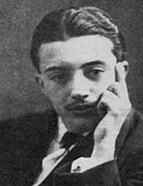

Of aristocratic origin, Luís de Montalvor, born in Cape Verde, had a relatively short life, shrouded in silence and contradictions. In the words of Arnaldo Saraiva, one of the pioneers who studied the author’s presence in Brazil in his doctoral dissertation, published in 1985: “Luís de Montalvor is one of the most unjustly treated and forgotten figures in 20th-century Portuguese culture. (...) little or nothing is known with certainty about his stay in Brazil, (...) his participation in the Orpheu project, (...) his editorial activities (...).” (A. Saraiva; O Modernismo Brasileiro... 1986, p. 171). He was one of the founders of the journal Orpheu in 1915, which published two issues (he edited the first, with Ronald de Carvalho), and of Centauro the following year (Introduction to Orpheu, 2nd ed. 1989, pp. 5-6; Tentativa..., 1916, pp. 7-12). During his adolescence, he was a classmate of Mário de Sá Carneiro at the Liceu de S. Domingos, where he completed a significant part of his schooling. (M. P. Silva, Montalvor, Luís de, 2008, pp. 486- 487). His activity began with the publication of a pamphlet alluding to the Republican Revolution of 5 October 1910, printed in the same year or the following year (A Revolução..., n.d.). Under the name Luís Ramos, he published A Noite de Satan in 1911 and A caminho in 1912, a collection of traditionalist poems. Arnaldo Saraiva suggests that the poet may have been the private secretary of his godfather Bernardino Machado (A. Saraiva, Idem, pp.172-173). When he returned to Lisbon, he joined Mário de Sá-Carneiro’s group. According to Manuela Parreira da Silva, he took the initiative to found Orpheu, and the name of the publication was his. Luís de Montalvor and Ronald de Carvalho appear as directors, perhaps for strategic reasons related to their connection to Brazil (R. Sousa, Os bastidores..., 2011, pp. 25-26; J). In 1925 and 1926, Montalvor’s poems were published in Athena and Contemporânea. In literary and editorial circles linked to modernism, there was, at times, a relationship between a sense of historical time and aesthetic experimentalism. Montalvor founded two publishing houses: Centauro, in 1916, where he exhibited a decadent aesthetic, and Ática, in 1930, which published two important historiographical works: História do Regime Republicano em Portugal and A arte indígena portuguesa, in collaboration with Diogo de Macedo (História…, 1930, pp. 5-8; A arte…, 1934). In the introductory text to the first work, he begins by distinguishing two reconcilable dimensions of history, narrative and the search for causality: “In history (...) there are two modes of being (...): one (...) evokes and depicts (...) facts, events (...); another (...) determines the causes (...)” (Advertência a História..., p. 5).
This work is financed by national funds through FCT - Foundation for Science and Technology, I.P, in the scope of the projects UIDB/04311/2020 and UIDP/04311/2020.
